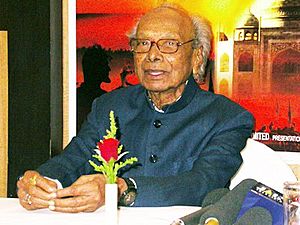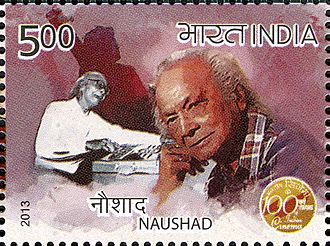Naushad facts for kids
Quick facts for kids
Naushad Ali
|
|
|---|---|

Naushad Ali in 2005
|
|
| Background information | |
| Born | 25 December 1919 Lucknow, United Provinces of Agra and Oudh, British India (present-day Uttar Pradesh, India) |
| Died | 5 May 2006 (aged 86) Mumbai, Maharashtra, India |
| Genres | Hindustani classical music • Indian film music |
| Occupation(s) | Composer, music director, film producer, writer, poet, producer |
| Instruments | Harmonium • sitar • piano • tabla • flute • clarinet • accordion • mandolin |
| Years active | 1940–2005 |
| Associated acts | Lata Mangeshkar, P. Suseela, Asha Bhosle, Mohammad Rafi, Mukesh (singer), Shamshad Begum, K.J. Yesudas, S. P. Balasubrahmanyam, Shakeel Badayuni, Majrooh Sultanpuri, D. N. Madhok |
Naushad Ali (born December 25, 1919 – died May 5, 2006) was a super famous Hindi film music director from India. Many people think he was one of the best music directors ever in the Hindi film world. He was especially known for making classical music popular in movies.
His first movie as an independent music director was Prem Nagar in 1940. His first big musical success was Rattan (1944). After that, he had many hits! He received the Dadasaheb Phalke Award in 1981 and the Padma Bhushan in 1992. These are two of India's highest honors for his amazing work in Hindi films.
Contents
Early Life and Musical Journey
Naushad Ali was born and grew up in Lucknow, a city in India known for its rich culture. His father, Wahid Ali, worked as a court clerk. As a child, Naushad loved visiting a yearly fair where many great musicians performed. He learned Hindustani music from famous teachers there. He also used to fix harmoniums, which helped him understand music even more.
As a young boy, he joined a small theater club. He became the music leader for their plays. He would watch silent films at the Royal theater in Lucknow. Back then, musicians would play live music during the movie. They would watch the film first, then play music that matched the scenes. This helped Naushad learn how to create background music for movies.
Naushad even started his own music group called Windsor Entertainers. He traveled with them, learning different folk music styles from places like Punjab, Rajasthan, and Gujarat. He learned classical and folk music even though his father didn't want him to. In late 1937, he moved to Mumbai to start a career in music.
Starting His Career in Mumbai
When Naushad first arrived in Mumbai, he didn't have much. He even slept on the footpath for a while! He started by helping famous music director Ustad Jhande Khan. He earned a small salary of 40 rupees a month.
Naushad was a good piano player. He worked as a pianist in another composer's orchestra. Later, composer Khemchand Prakash hired him as his assistant. Naushad was always very thankful to Khemchand, calling him his teacher.
His friend, a lyricist named D. N. Madhok, believed in Naushad's talent. He introduced Naushad to different film producers. Naushad got his first chance to compose music for a film called Prem Nagar in 1940. He even researched the folk music of the Kutch area for this film.
He started working regularly for Kardar Productions. His first big recognition came with Sharda (1942). A 13-year-old singer named Suraiya sang her first song for this movie. But it was Rattan (1944) that made Naushad super famous. After Rattan, he became one of the highest-paid music directors.
Naushad's family in Lucknow didn't know he was a music composer. When he got married, the band played songs from his hit film Rattan. His father and father-in-law were criticizing the musician who composed those songs, not knowing it was Naushad himself! Naushad understood both Hindu and Muslim cultures well.
From 1942 until the late 1960s, Naushad was one of the top music directors in Hindi films. He worked on 65 films in his lifetime. Many of his films were huge successes, running for many weeks in theaters.
He worked with many talented lyricists (songwriters) like Shakeel Badayuni and Majrooh Sultanpuri.
Mother India (1957), a film he composed music for, was the first Indian film to be nominated for an Oscar award.
Naushad even composed music for the TV serial "Akbar The Great" in 1988. He also worked on "The Sword of Tipu Sultan" in 1990, which was very popular.
His Unique Music Style
Naushad brought a new style to film music. He based his tunes on classical music ragas and folk music. He was great at using classical music in movie songs. For example, in the movie Baiju Bawra, all the songs were based on classical ragas. He even had a famous classical singer, Amir Khan, help as a music consultant for the film.
Naushad was also good at using Western instruments. He could use the clarinet, mandolin, and accordion in his songs. He was one of the first to mix the flute and clarinet, or the sitar and mandolin. He also introduced the accordion to Hindi film music. He was among the first to focus on background music. This helped to show the characters' feelings and make the dialogue more powerful.
One of his biggest contributions was bringing Indian classical music into films. Many of his songs were inspired by ragas. He even used famous classical artists like Amir Khan in Baiju Bawra (1952) and Bade Ghulam Ali Khan in Mughal-e-Azam (1960). Baiju Bawra helped him win the first Filmfare Best Music Director Award in 1954.
Naushad once said about Baiju Bawra: "When people heard the film would be full of classical music, they worried. But I wanted to change what people liked. We showed them music from our culture, and it worked!"
For the film Aan (1952), he was the first to use a huge orchestra with 100 musicians. He was also the first composer in India to use a system of Western music notation. The music for Aan was even published as a book in London!
In Uran Khatola (1955), he recorded an entire song without any instruments. He used only the sound of people humming! For Mughal-e-Azam (1960), he used a chorus of 100 people for the song "Ae Mohabbat Zindabad." For Ganga Jamuna (1961), he used lyrics in a special local language called Bhojpuri.
As film music changed in the late 1960s, some people thought Naushad's style was old-fashioned. But he was still seen as a master. He was often asked to compose for historical movies where traditional music was needed. Naushad set high standards for Indian classical and folk music in films. He showed how beautiful Indian music could be in a short film song.
Later Years and Legacy
Naushad composed the music for Taj Mahal: An Eternal Love Story (2005) when he was 86 years old. This was his last released work.
Naushad passed away on May 5, 2006, in Mumbai, at the age of 86. He is remembered as one of the most respected and successful music directors in the Indian Film Industry.
He had asked the government to create a place for promoting Hindustani music. This wish came true, and the 'Naushad Academy of Hindustani Sangeet' was formed.
Writer and Producer
Naushad was also a talented poet. He published a book of Urdu poetry called Aathwaan Sur ("The Eighth Note"). He also released an album with the same name, featuring his poems set to music.
He also worked as a producer for films like Maalik (1958), Uran Khatola (1955), and Babul (1950). He wrote the stories for Palki (1967) and Teri Payal Mere Geet (1989).
Awards and Recognition
Naushad received many awards for his amazing contributions to music:
- 1954: Filmfare Best Music Director Award for Baiju Bawra
- 1981: Dadasaheb Phalke Award (India's highest film honor)
- 1992: Padma Bhushan Award (one of India's highest civilian awards)
- 2000: Screen Lifetime Achievement Award
- In 2008, a road in Mumbai was renamed Sangeet Samrat Naushad Ali Marg (Music Emperor Naushad Ali Road) in his memory.
Filmography (Selected)
Naushad composed music for many films. Here are some of his notable works:
- Prem Nagar (1940)
- Nai Duniya (1942) - Singer Surayya's debut
- Sharda (1942)
- Rattan (1944) - A huge hit!
- Anmol Ghadi (1946)
- Mela (1948)
- Andaz (1949)
- Babul (1950) - Also producer
- Deedar (1951)
- Aan (1952) - Used a 100-piece orchestra
- Baiju Bawra (1952) - Won him an award
- Uran Khatola (1955) - Also producer
- Mother India (1957) - Nominated for an Oscar
- Mughal-e-Azam (1960) - Featured classical singers
- Gunga Jumna (1961) - Used Bhojpuri dialect
- Mere Mehboob (1963)
- Ram Aur Shyam (1967)
- Pakeezah (1972) - Background score and some songs
- Taj Mahal: An Eternal Love Story (2005) - His last film
Images for kids




